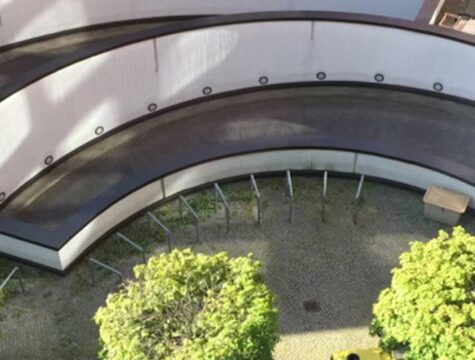New Years eve in Berlin has just passed, and unfortunately (but predictably) the streets are covered in the waste that an all-out evening of fireworks leaves behind – plastic shards, wooden sticks, damp cardboard and an odd looking red dust. But look a little closer, and in amongst this you’ll see a pair of jeans slung across a locked up bike, a pile of childrens clothing gathered around the base of a tree, or a lone shoe nestling on a window sill.
Increasingly clothing and household textiles can be found scattered across the streets of Berlin. Discarded and left to the elements, these items are left to deteriorate, even though they still contain value and can very likely still be worn.
In Berlin alone, 67,000 tonnes of textiles are disposed of yearly, with half of this – around 33.5 tonnes – incinerated. This means that textiles are being incinerated before being given the chance to circulate through the shorter loops of the Circular Economy – Reuse & Repair. These loops recover the most value from the textiles and save on resources needed to create new products. And not to forget the social aspect of providing clothing and warmth to those in our community who are in need.

So we asked ourselves, what if we could rescue these textiles from the streets before they are incinerated as waste? Or one step better – what if we could educate our local communities and help prevent these textiles from ending up discarded on the streets?
And with this, Textile Journeys was born.
Textile Journeys is an interactive deep dive into discarded textiles and consists of 3 parts:
1: Street Tour
2: Investigation Time
3: DIY Workshop
It was developed together with our partner, STREETWARE Saved Item – a Berlin based NGO who have been organising their own textile activism performances and events, such as the STREET-shopping tour, since early 2021.
As well as raising awareness of this local (but at the same time, global) issue, and providing Berlin citizens with practical solutions for textile waste prevention, Textile Journeys is also a platform for the thousands of #textilretters business and organisations already existing in Berlin – many of which can be found on the The A-Gain Guide.
We piloted Textile Journeys on Saturday 19.11.2022 in Neukölln – a district in Berlin that is often overwhelmed with discarded items.
Our journey started at Hermanstrasse, where participants were greeted by Alice Fassina from STREETWARE Saved Item, and Jojo Shone, a member of our Circular Berlin Textiles Team.
After a short introduction by Alice, our determined group of 9 participants got stuck into the first part of our mission – the Street Tour. After just 20 minutes, STREETWARE saved items specially crafted “Multifunctional Hybrid Laundro Drive” aka mobile clothes horse, was full of textiles rescued from the streets – despite the fact that the local municipality had cleaned the area only days before.





Despite the weather conditions (it was quite cold and threatening to snow), spirits in the team remained high, as textiles were found under cars, alongside railway track fences, and in the corners that the waste collectors didn’t look.
Surprised at the amount they had found, the group moved indoors, to the community space at Kulturlabor Trial & Error. After a tea and coffee break to help warm everybody up, and a short video on clothing exports to India, we gathered around the large table for part two – Investigation Time. Just what ARE these unwanted textiles? And why are they ending up discarded on the streets?
Each person received some items to examine in further detail. As we still needed to wash the items we’d just collected, we used items from a previous street collection.
Specifically, we looked at where a piece of clothing or textiles was made ie. “Country of Origin”, what it was made of, and the reasons why someone could have decided they no longer wanted it. The results were, on one hand, just what you would expect, but on the other hand, quite surprising!
Most pieces either had no “country of origin” information available (it’s not actually a legal requirement to include this on a care label) or were made in China or Bangladesh. One item curiously stated that it was “Made for Germany”, as opposed to “Made in Germany”.
And it’s worth noting that over half of the 50 items seemed to have no “problems” such as stains, holes or looking “worn”, and could easily be worn again.
Throughout we had some great discussions, on topics such as clothing care, digital product passports and what “country of origin” actually means, as the group shared their thoughts, knowledge and experiences with each other.
Investigation Time done, we moved onto a bit of DIY with the third part of our programme – an Upcycling Workshop. This is the opportunity to showcase of amazing #textilretters from the A-Gain Guide, so they share their knowledge and skills! Of the 481 alteration shops, 46 sewing cafes, 37 flea markets, 186 shoe repair services and 45 upcycling services/workshops listed, we were extremely happy to welcome the lovely Karen Rose. Karen Rose has been offering workshops on the topics of zero waste and upcycling since 2016, and showed us how to transform unwanted t-shirts into T-shirt yarn, and then into macrame keychains.
We all got stuck into making our keyrings – slipping into a meditative state, as the rhythmic sound of scissors cutting through fabric filled the room, and the snow fell down outside.




It was a real pleasure to host this Textile Journeys pilot event, and a big Thank You to all who took part, including our partner STREETWARE Saved Item! We can’t wait to be able to roll this out on a larger scale, rescue some more discarded textiles and empower even more of Berlin’s citizens to understand and cherish the value in their clothing. Stay tuned and contact us for cooperation.
The article is prepared by Cherelle Escaffre




